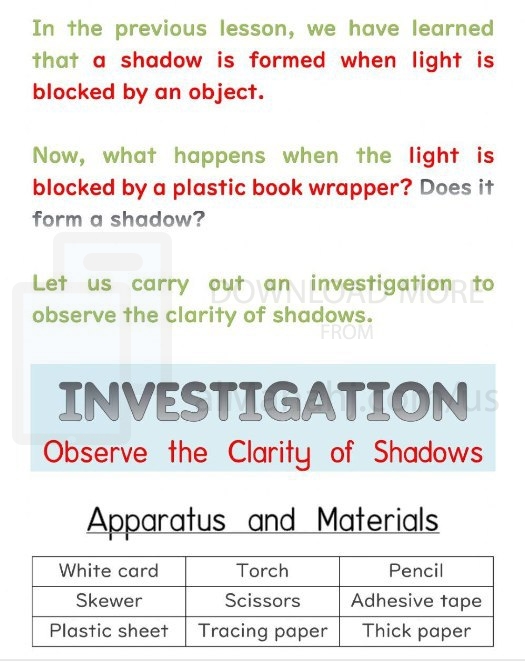File info: A Worksheet about Light and Dark and Clarity of Shadows is an educational resource designed to help students explore and understand the concepts of light, dark, and the clarity of shadows. The worksheet provides various activities and questions to engage students in learning about how light and shadows interact and affect our perception of brightness and darkness. Here's a description of what a Worksheet about Light and Dark and Clarity of Shadows might include:
1. Introduction: The worksheet begins with an introduction that introduces the topic of light, dark, and shadows. It may provide a brief explanation of how light travels, how shadows are formed, and how they can vary in terms of clarity.
2. Definitions and Terminology: The worksheet includes definitions and explanations of key terms related to light and shadows. It may define terms such as light source, shadow, darkness, brightness, and clarity of shadows to ensure students have a clear understanding of the vocabulary used throughout the worksheet.
3. Observation Activities: The worksheet may include observation activities where students are asked to observe and describe different lighting conditions and the resulting shadows. Students may be prompted to describe the clarity of shadows in various situations, such as when the light source is close or far away, or when there are multiple light sources.
4. Experiments or Demonstrations: The worksheet may provide instructions for simple experiments or demonstrations that allow students to explore the relationship between light, dark, and the clarity of shadows. For example, students may be asked to manipulate the position of a light source and observe how it affects the size, shape, and clarity of shadows.
5. Diagrams or Visuals: The worksheet may include diagrams or visuals that illustrate the concepts of light, dark, and shadows. These visuals can help students visualize the relationship between light sources, objects, and the resulting shadows.
6. Questions and Problem-Solving: The worksheet includes questions that require students to apply their understanding of light, dark, and shadows to solve problems or answer specific scenarios. Students may be asked to predict how changing certain factors, such as the distance between the light source and an object, will impact the clarity of the shadow.
7. Reflection and Critical Thinking: The worksheet may include reflection questions or critical thinking activities that encourage students to analyze and evaluate their observations. Students may be prompted to explain the reasons behind their observations, make connections to real-life situations, or propose solutions to improve the clarity of shadows in specific scenarios.
8. Vocabulary and Concept Review: The worksheet provides opportunities for students to reinforce their understanding of the vocabulary and concepts related to light, dark, and shadows. It may include activities such as matching definitions to terms, completing sentences with the appropriate words, or creating their own explanations for specific concepts.
The purpose of a Worksheet about Light and Dark and Clarity of Shadows is to engage students in hands-on exploration and critical thinking about the properties of light, dark, and shadows. The worksheet helps students develop an understanding of how light sources and objects interact to create shadows with varying degrees of clarity. It also encourages students to make observations, draw conclusions, and apply their knowledge to real-world situations. Additionally, the worksheet serves as a tool for teachers to assess students' understanding of the topic and guide further instruction if needed. |
